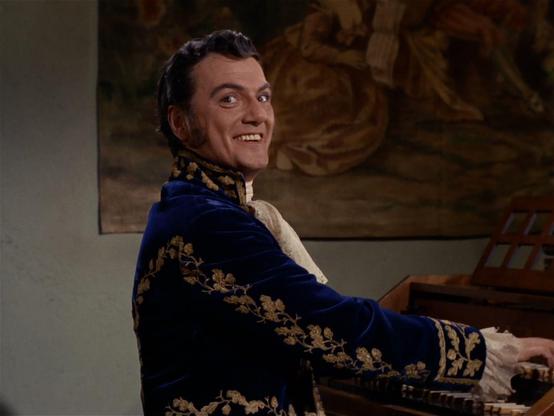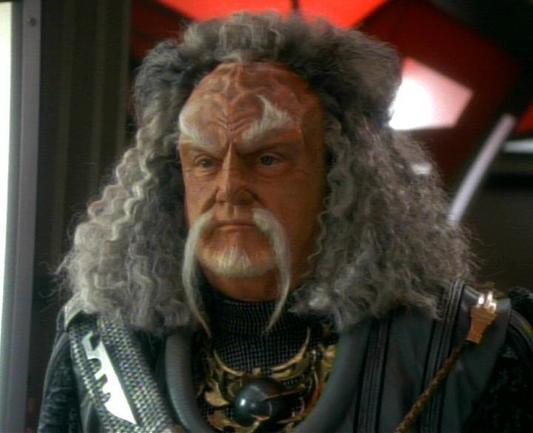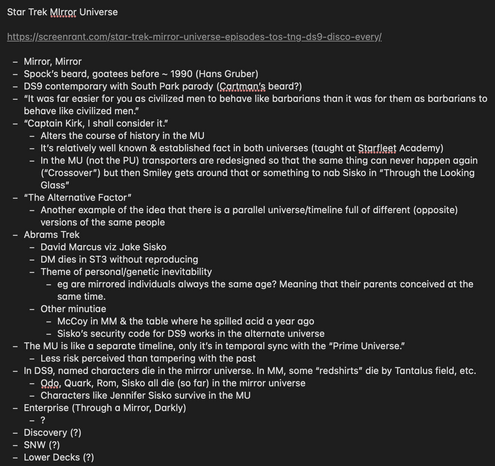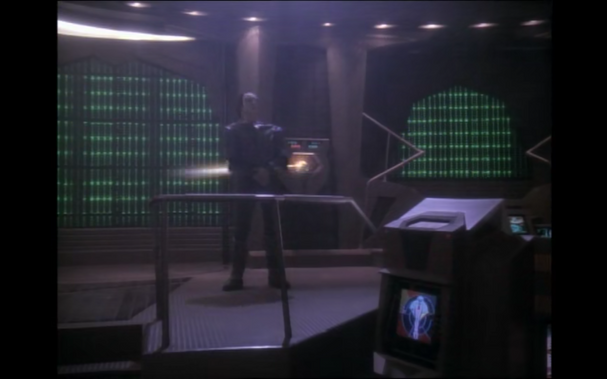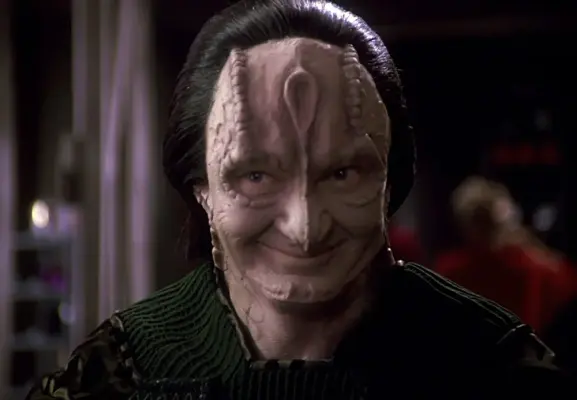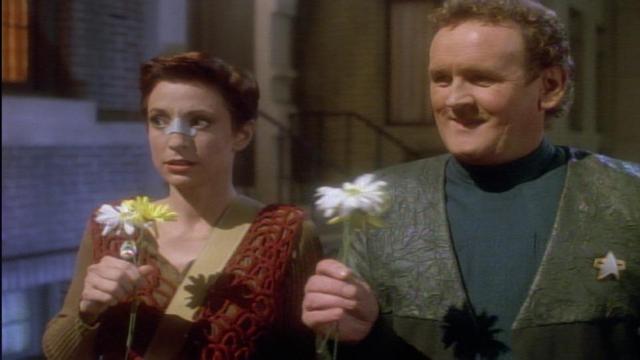Recent searches
Search options
Thanks to the miracle of the internet, as it were, I’ve been watching Deep Space 9. I had flashbacks through the first few episodes, up to “A Man Alone.” I had seen the first few, it seems. It turns out that most of what I remembered about the series was the pilot, “Emissary.” I remembered Sisko meeting Picard for the first time & the species outside time. That plot is heavily influenced by Stanislaw Lem’s novel “Solaris,” btw. In that novel (made into two films in 1972 & 2003), an incomprehensible alien probes human minds & produces whatever it finds to be significant, usually something horribly painful. Until the last few days, all I really remembered of DS9 was that they were not bringing him there, back to Wolf 359 & the death of his wife. He just never left.
Anyhoo. I’ll probably make a few notes as I go.
Here’s the first. From “A Man Alone,” in which a Bajoran terrorist fakes his own death to frame Odo for his murder. At one point, he & Sisko discuss the terrorist:
Odo: His name is Ibudan. He used to run black market goods through here to the surface during the Cardassian occupation, gouging his fellow man who needed medical supplies & so forth. Some Bajorans actually considered him a hero. But I saw him let a child die when the parents couldn’t afford the drug that would’ve saved her life.
That was 31 years ago from the same series that brought us the Bell Riots (which I’ll get to sooner or later). Plucked right out of last week’s headlines.
So before I even started at the beginning, I watched "Blood Oath" (S02E19), which I posted about recently. Naturally, as a Trekkie since more than a decade before TNG, this one has plenty of charms for me. But it brings a bit of closure in a certain sense. The first episode I can ever remember seeing is "The Squire of Gothos." And while it may not be the same character, seeing the end of Koloth brings something full circle.
The performances by the three Klingons were excellent. John Colicos, who also played Baltar in Battlestar Galactica, was a spectacularly colorful washed-up Kor. But Kor was always expressive. The episode more or less began and ended with him singing. (And apparently dying off camera, unlike the other two.)
Of the originals, Kor is by far my favorite, though I liked all three. But I was also quite impressed by Michael Ansara as an older, wiser Kang. I really enjoyed his voice & sometimes had a difficult time connecting it with the harder voice of the earlier Kang.
Anyway, achievement unlocked.
Supplemental log:
Watched "The Sword of Kahless" (S4E9). Kor's still kicking.
Now that I'm well into the 4th season of #StarTrekDS9, I've seen 2 of 5 mirror-universe episodes. This seems to be one of those recurring themes, like Tribbles, in #StarTrek series. I thought every series had a mirror-universe episode, but apparently TNG did not? And then DS9 took it and ran with it. But Voyager skipped it?
I've seen all of Enterprise & sorta recall "Through a Mirror, Darkly." Sorta = basically not at all.
I can catch up on a lot through Memory Alpha w/o a P+ subscription.
It's spawned so many thoughts I guess I'm writing a book about it. Lol
So obviously the MU theme struck me. And numerous other things. But I have to say, the two most engaging characters in the whole series are the two Cardassians we see most: Garak & Gul Dukat.
I'm not certain if I think Garak is becoming less interesting as we learn more. At first his opacity & charm make him intriguing. But there's no longer any surprise when the simple tailor hacks into a security system or knows what's going on before anyone else. (Eg in "The Way of the Warrior," Sisko just invites G in to measure him for a suit in order to warn the Cardassians of an attack.) I think I learned from MA that his father is Enabran Tain (now dead). I still have half a series to go tho.
One of the funniest things I can recall seeing in some time was a scene in "Civil Defense," in the 2nd or 3rd season, when a Cardassian booby trap has been sprung & a synthesized phaser turret is firing around Ops. Everyone is ducking for cover. Dukat beams in directly in front of the turret, knowing it won't fire on Cardassians, and stands there gesticulating & pontificating, punctuated by phaser blasts, thinking he has the whole thing in hand. Had to pause it to stop laughing.
I’ve been thinking a good deal about the writing in #StarTrekDS9 & the evolution of TV in the last decades. Unlike, say, Star Wars, #StarTrek has primarily revolved around broadcast TV series (now streaming/subscription, like every other new series). TV itself has evolved & you can see it in Star Trek.
TOS was a relatively unordered series. Outside of the two parts of “The Menagerie,” there are a handful of episodes that mention the events of others. Of course, if you like, you can sequence most of them by Stardate, but that's not the same as the original broadcast order. For the most part, you can watch TOS in virtually any order. I’ve known every TOS episode by title since the 70s. I have almost no idea which season they occurred in. It’s irrelevant, at least to the narrative. TOS was situational sci-fi, like situational comedy: It revolved around a fixed set of characters in a fixed situation & followed them through episodic encounters. At the end of each episode, everything was always back to normal. Not many Star Trek fans can tell you if “Shore Leave” was before or after “A Taste of Armageddon.” Who cares?
One series that stands out for its departure from this sort of formula is “The X-Files,” contemporary with DS9, which was known for its “mythology” (the business revolving around the smoking man, Mulder’s sister & gov’t conspiracies & cover-ups) & episodic content, simply Mulder & Scully in this week’s adventure, just like the crew of the Enterprise in TOS. But every now & then, usually at the beginning & end of each season & often in multipart cliffhanger episodes mid-season, the main storyline would resume for a bit in dramatic fashion, only to end up unresolved, promising more in the future.
This exactly describes the structure of Enterprise & the narrative about the Temporal Cold War & the formation of the Federation. I think this structure was still evolving in the early seasons of DS9, but it solidifies by the 3rd season or so.
Today all new TV shows seem to be miniseries for paid subscribers. I always used to think that there always had to be 26 episodes in any TV season, one a week for half the year (hence, a “season,” not a year). Now 8 paid installments is a “season,” which occurs every couple of years if you’re lucky.
But episodic TV has largely disappeared.
#StarTrekDS9 gets to be a bit formulaic at times. It’s strange even how often the same formula appears in two consecutive episodes. Most episodes have titles that may apply, sometimes with a bit of irony or metaphor, to two different storylines. For example, “Playing God” involves a decision about the fate of some proto-universe almost-roadkill on a runabout as well as another narrative about Dax tutoring a hopeful Trill initiate & holding power over his future.
The scripts explore the characters & their relationships as a rule to the point that it almost becomes a space soap opera. There are eps of TOS that revolve around something like Spock & his history & family (“Amok Time,” “Journey to Babel”) or McCoy having a year to live because of a disease (“For the World is Hollow & I Have Touched the Sky”). There’s more resistance to progress than anything else. At the end of a few episodes, Spock comically and resolutely refuses to admit having displayed any emotion, or he & McCoy bicker until Kirk cuts them off, etc.
In fact, in TOS, Spock is notably the ONLY non-human on the Enterprise. Much is made of his alienness & his struggles living among humans. In large part, the TOS episodes about him explore Vulcan culture, families, rituals, etc. These eps are less about developing the character than the species.
If I had to guess, I’d say at least half the episodes of DS9 involve characters in unlikely pairs in a runabout, often “coming to terms” or something similar. My faves, in fact, are the ones with Bashir & O’Brien because they almost never see eye-to-eye. They grow to respect each other a bit grudgingly, but they often avoid or at least resist the formulaic emoting, much more like Spock & McCoy in the original series.
And finally I guess I think it’s disturbing the way that DS9 belabors the Bajoran and other religions. It’s one thing to portray a primitive culture as worshiping deities, but much is made of Bajoran spirituality. It’s a disappointing turn for a franchise that started out kicking the gods whenever possible & has, I think, exactly two lines anywhere in TOS that betray that idea, possibly for the benefit of censors or something.
I guess I should spare a moment for “Past Tense,” one of #StarTrekDS9’s best-known (two-part) episodes, which I’ve finally seen. It’s been much discussed, especially this year & I had read the MA plot summary before. The most surprisingly accurate thing, which I’d never seen mentioned, was when the guard who first detains Sisko & Bashir (the mouthy prisoner at the end, who is the last one to come around after Sisko has taken a bullet) is cursing the ads (!) that are showing up on his console at work while he’s trying to do his job. Phew. I felt that one.
Obviously this episode is heavily inspired by “The City on the Edge of Forever” and shares with it some details: three are stranded in the past, a pair and a loner looking for each other; some of the others are left in the “present” and can detect that Starfleet is gone because history has been changed. In the first case, of course, Edith Keelor must die. In the second, Gabriel Bell dies helping the visitors from the future, who then have to fill the gap.
This reminds me a bit of the plot of Asimov’s “The End of Eternity,” in which Eternity, a time-travel organization, is founded on a paradox because fundamental knowledge was not discovered but brought back from the future to the 20th cy to the organization’s founder. Or would have been, had the founder not died. The time traveler from the future was left to impersonate and become the actual founder of the organization that sent him back to assist.
What’s funny is at first I kept thinking, they’ve traveled back to the 90s. Only to realize, oh right, they traveled back to this very summer. Predicting the relatively near future is always going to be risky or fail. Consider that the time interval between the airing of “Past Tense” and the events it predicts was about the same as “Space Seed” predicting the Eugenics Wars of the 90s, another couched dystopian warning. Which, as much as I love that episode & as important as Khan is to the franchise, always makes me giggle thinking of Jerry Seinfeld & Jennifer Aniston instead of genetically-engineered superhumans. I’d say “Past Tense” landed much nearer the actual mark. The main failure was overestimating empathy in the 21st cy.
There are some fun bits, like Kira & O’Brien beaming around to different time periods only to dematerialize holding flowers & making peace signs in front of a couple of stoned Boomers. I’d like to burn every one of Dax’s 2024 costumes. I think a few episodes later, is it Jake & Nog who mention the resemblance of Bell in the history books to Sisko?
Oh, and nearly forgot the gorgeous exchange between Dax & the “dim” who had her commbadge. “I’m an alien,” ed note: accurate, “and I’m here to defend the Earth from its enemies, but I need that piece of jewelry.”
I think it’s so well-known & I knew so much about it that there weren’t many surprises. Definitely a high point for the series.
OK, so a little off-topic, but thinking about Kira's "I broke my nose" in "Past Tense" and comparing with "The City on the Edge of Forever" brought to mind this unfortunate line:
"My friend is obviously Chinese."
Which brings up a host of questions that lead unpleasant places. But I find myself wondering if it was Harlan Ellison or Gene Roddenberry who was responsible for that line.



